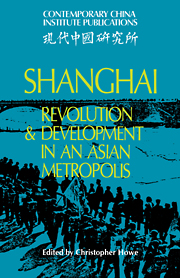Book contents
- Frontmatter
- Contents
- List of illustrations
- Preface
- Foreword
- Abbreviations
- PART ONE THE MODERN HISTORICAL PERSPECTIVE
- 1 ‘The Other China’: Shanghai from 1919 to 1949
- PART TWO POLITICAL LIFE
- PART THREE ECONOMIC DEVELOPMENT AND LIVING-STANDARDS
- PART FOUR THE SUBURBAN TRANSFORMATION
- PART FIVE CULTURE AND IDEOLOGY
- Notes
- A chronology of modern Shanghai, 1842–1979
- Contributors
- Index
1 - ‘The Other China’: Shanghai from 1919 to 1949
Published online by Cambridge University Press: 14 October 2009
- Frontmatter
- Contents
- List of illustrations
- Preface
- Foreword
- Abbreviations
- PART ONE THE MODERN HISTORICAL PERSPECTIVE
- 1 ‘The Other China’: Shanghai from 1919 to 1949
- PART TWO POLITICAL LIFE
- PART THREE ECONOMIC DEVELOPMENT AND LIVING-STANDARDS
- PART FOUR THE SUBURBAN TRANSFORMATION
- PART FIVE CULTURE AND IDEOLOGY
- Notes
- A chronology of modern Shanghai, 1842–1979
- Contributors
- Index
Summary
In 1953 Rhoads Murphey published a book called Shanghai: Key to Modern China. Twenty-five years later, the same writer asserted that this was not the right key, and that Shanghai, bridgehead for penetration to the West, had played hardly any role in the evolution of modern China. The quarter of a century which has passed invites us to take stock; and it allows us to analyse the experience of treaty ports, in particular the port of Shanghai, without too much good – or bad – feeling.
For the Revolution of 1949 eliminated, if not Shanghai itself, at least the model of development inspired by the West of which the city had become the symbol. Without doubt this elimination was less radical than is generally admitted. The specific quality which Shanghai retained within the communist framework was owed, it is thought, to the survival of certain characteristics inherited from a century of historical experience (1842–1949).
It was towards 1919 that the Shanghai model reached its peak whilst, at the same time, revealing its weakness. In fact, from one world war to the next, Shanghai did not cease to develop, increase its population, and strengthen its economic power, its political and its cultural influence. The degrading of its international status, however, endangered the foundation of a prosperity which, for a century, had been built upon integration with the world market, and on a relative independence from the bureaucratic Chinese government. It is true that Shanghai held other trumps: – her exceptionally favourable geographical situation; advances made in the spheres of industry, technology and finance; an active middle class and a relatively established working-class tradition.
- Type
- Chapter
- Information
- ShanghaiRevolution and Development in an Asian Metropolis, pp. 1 - 34Publisher: Cambridge University PressPrint publication year: 1981
- 10
- Cited by

